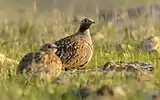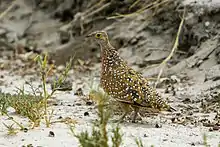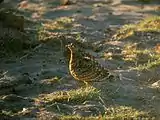| Pterocles | |
|---|---|
 | |
| Spotted sandgrouse | |
| Scientific classification | |
| Domain: | Eukaryota |
| Kingdom: | Animalia |
| Phylum: | Chordata |
| Class: | Aves |
| Order: | Pterocliformes |
| Family: | Pteroclidae |
| Genus: | Pterocles Temminck, 1815 |
| Type species | |
| Tetrao alchata (pin-tailed sandgrouse) Linnaeus, 1766 | |
| Species | |
|
See text | |
Pterocles is a genus of near passerine birds in the sandgrouse family. It includes all the species in the family except for two central Asian species in Syrrhaptes.
These sandgrouse have small, pigeon-like heads and necks, but sturdy compact bodies. They have long pointed wings and sometimes tails. Their legs are feathered down to the toes, but unlike species of the genus Syrrhaptes the toes are not feathered.
Pterocles species have a fast direct flight, and flocks fly to watering holes at dawn and dusk.
Two to three eggs are laid directly on the ground. They are buff or greenish with cryptic markings. All species are resident.
Taxonomy
The genus Pterocles was introduced in 1815 by the Dutch zoologist Coenraad Jacob Temminck.[1] The type species was subsequently designated by the English zoologist George Robert Gray as the pin-tailed sandgrouse.[2][3] The genus name combines the Ancient Greek pteron meaning "wing" with -klēs meaning "notable" or "splendid".[4]
Species
The genus contains 14 extant species:[5]
| Image | Common Name | Scientific name | Distribution |
|---|---|---|---|
.jpg.webp) | Pin-tailed sandgrouse | Pterocles alchata | North Africa and the Middle East, Turkey, Iran, Iraq and Kazakhstan, Spain, Portugal |
 | Namaqua sandgrouse | Pterocles namaqua | Angola, Namibia, Zimbabwe, Botswana, Lesotho and South Africa |
 | Chestnut-bellied sandgrouse | Pterocles exustus | central and northern Africa, and southern Asia |
_(cropped).jpg.webp) | Spotted sandgrouse | Pterocles senegallus | Morocco, Algeria, Tunisia, Libya, Sudan, Egypt, Eritrea, Somalia, Ethiopia, Djibouti, Mali, Mauritania, Chad and Niger |
 | Black-bellied sandgrouse | Pterocles orientalis | Iberia, northwest Africa, the Canary Islands, Turkey, Iran, Cyprus and Israel |
 | Crowned sandgrouse | Pterocles coronatus | North Africa and the Middle East. |
 | Yellow-throated sandgrouse | Pterocles gutturalis | Angola, Botswana, Eritrea, Ethiopia, Kenya, Namibia, South Africa, Tanzania, Zambia, and Zimbabwe. |
 | Burchell's sandgrouse | Pterocles burchelli | Angola, Namibia, Botswana, Zambia, Zimbabwe and South Africa |
| Madagascar sandgrouse | Pterocles personatus | Madagascar | |
 | Black-faced sandgrouse | Pterocles decoratus | Ethiopia, Kenya, Somalia, Tanzania, and Uganda. |
 | Lichtenstein's sandgrouse | Pterocles lichtensteinii | Algeria, Chad, Djibouti, Egypt, Eritrea, Ethiopia, Libya, Mali, Mauritania, Morocco, Niger, Senegal, Somalia, Sudan, Uganda, Iran, Iraq, Jordan, Oman, Pakistan, Palestine, Saudi Arabia, Israel, the United Arab Emirates and Yemen. |
 | Double-banded sandgrouse | Pterocles bicinctus | southern Africa. |
 | Painted sandgrouse | Pterocles indicus | Bangladesh, India and Pakistan. |
_female.jpg.webp) | Four-banded sandgrouse | Pterocles quadricinctus | Africa from Mauritania and Cameroon east to Sudan and Uganda |
A fossil species, Pterocles bosporanus, is known from the early Pleistocene of Crimea.[6]
References
- ↑ Temminck, Coenraad Jacob (1815). Histoire Naturelle Générale des Pigeons et des Gallinacés (in French). Vol. 3. Amsterdam: J. C. Sepp et fils. pp. 238, 712.
- ↑ Gray, George Robert (1840). A List of the Genera of Birds : with an Indication of the Typical Species of Each Genus. London: R. and J.E. Taylor. p. 62.
- ↑ Peters, James Lee, ed. (1937). Check-List of Birds of the World. Vol. 3. Cambridge, Massachusetts: Harvard University Press. p. 3.
- ↑ Jobling, James A. (2010). The Helm Dictionary of Scientific Bird Names. London: Christopher Helm. p. 322. ISBN 978-1-4081-2501-4.
- ↑ Gill, Frank; Donsker, David; Rasmussen, Pamela, eds. (January 2022). "Turacos, bustards, cuckoos, mesites, sandgrouse". IOC World Bird List Version 12.1. International Ornithologists' Union. Retrieved 14 August 2022.
- ↑ Zelenkov, N. V. (2023-08-01). "A New Species of Sandgrouse (Aves: Pteroclidae) from the Early Pleistocene of the Crimea". Doklady Biological Sciences. 511 (1): 264–266. doi:10.1134/S0012496623700497. ISSN 1608-3105.
External links
- Sandgrouse videos on the Internet Bird Collection